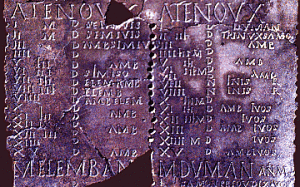Coligny Calendar, The
The Coligny Calendar is the name given to a fragmented bronze plaque discovered in 1897 near Coligny in France. It is a calendar that has been attributed to the Celtic Sequani tribe. It is dated to the 2nd century AD, written in Roman script in Gallic and is the longest known document in that language.
Paul Dunbavin in his Atlantis of the West[099] proposed that the Coligny Calendar might be considered a lunisolar calendar. Some years later in 2005 he returned to the subject in Under Ancient Skies[101] and devoted Chapter 5 plus Appendices A & B to a discussion of Critias 119d, which relates how the kings of Atlantis met alternatively every five and six years. Dunbavin suggests that this is reflected in the Coligny  Calendar and that it possibly had antecedents that would bring its functions back to the time of Bronze Age Atlantis>(d), if not earlier(e).<Dunbavin’s reaction to the Calendar is best quoted – Now it is this passage more than any other that convinces the present author (Dunbavin) of the authenticity of the Atlantis myth“. He touches on the subject again in his latest offering, Towers of Atlantis [1627] and Prehistory Papers [1758].
Calendar and that it possibly had antecedents that would bring its functions back to the time of Bronze Age Atlantis>(d), if not earlier(e).<Dunbavin’s reaction to the Calendar is best quoted – Now it is this passage more than any other that convinces the present author (Dunbavin) of the authenticity of the Atlantis myth“. He touches on the subject again in his latest offering, Towers of Atlantis [1627] and Prehistory Papers [1758].
Alexios Pliakos, a Greek student of ancient calendars, presented a paper to the 2008 Atlantis Conference entitled A hidden Calendar in the Atlantis Story. He focused on the same Critias 119d text and like Dunbavin has independently concluded that the reference to the five and six years is strong evidence “that Atlantis did not lie in Plato’s imagination.”
There have been attempts to link the Coligny Calendar with the much earlier stone engraving found at Knowth near Newgrange in Ireland(a). An extensive and more speculative discussion of the Calendar is to be found on a New Zealand website(b). Perhaps the most exotic explanation for the source of the Calendar, questions the presumed Celtic origins and offers reasons to consider a claim that it can be traced back to ancient India(c).
>A 2020 paper by Helen Mckay entitled The Coligny Calendar: A Full Reconstruction with Modern Dates from 30 April 2020 to 4 May 2025 is freely available.(f)<
(a) https://www.sequanicalendar.com/egg.html (Link broken Nov. 2018)
See: https://web.archive.org/web/20170305004709/https://www.sequanicalendar.com/egg.html
(b) http://www.celticnz.co.nz/Coligny/ColignyPart1.htm
(c) The Coligny Five Year Yuga | MalagaBay (archive.org)
(d) e5604c_465f3f96346041fb94f8e5f960804f1f.pdf (filesusr.com) *
(e) (99+) (PDF) The Neolithic Calendar in Plato’s Critias | Paul Dunbavin – Academia.edu *
